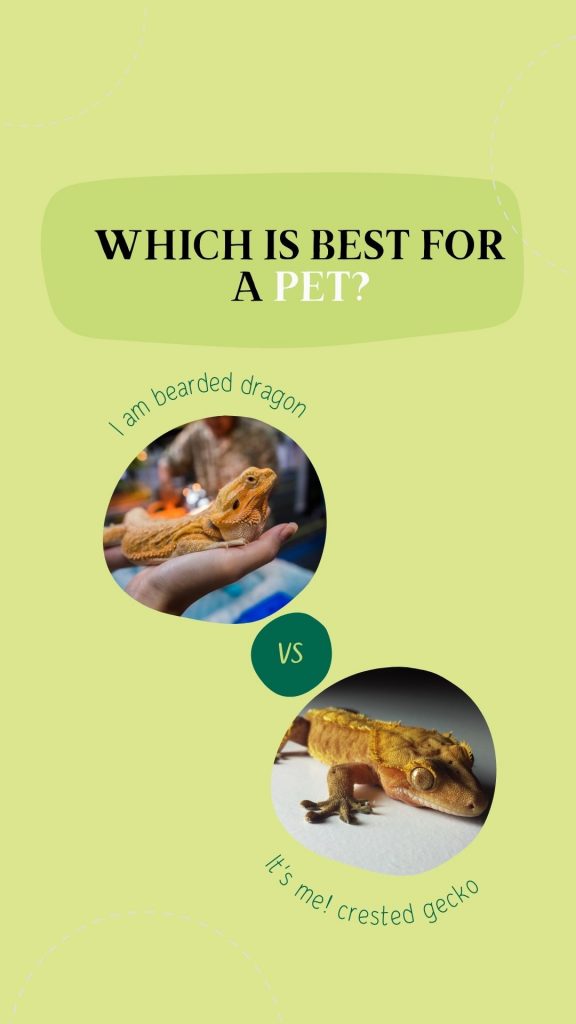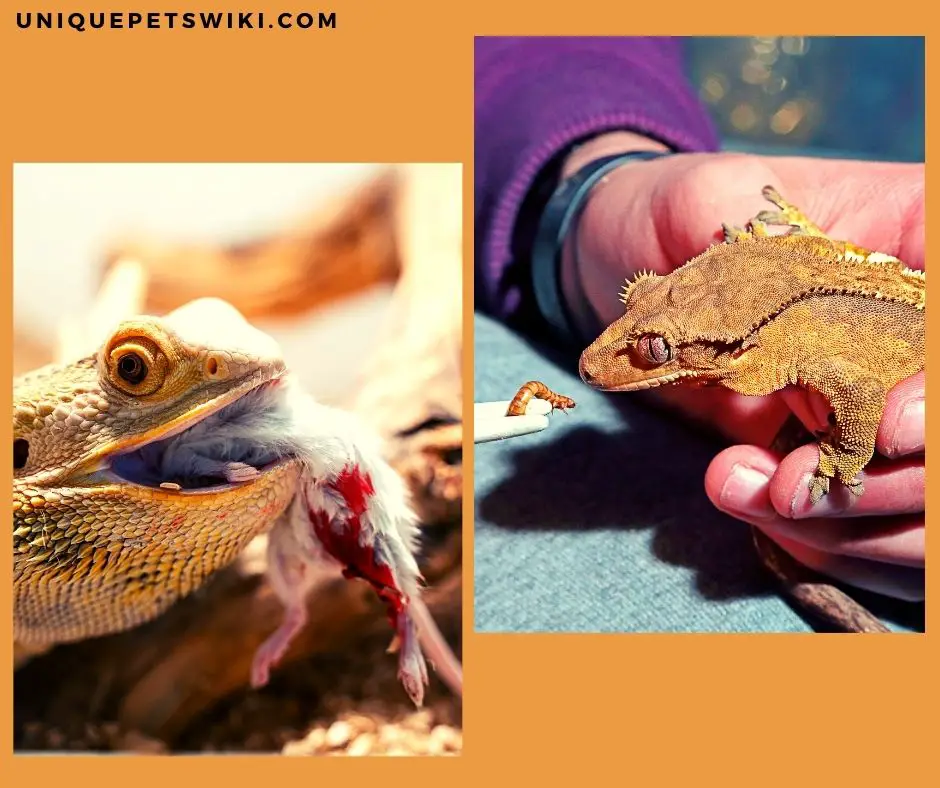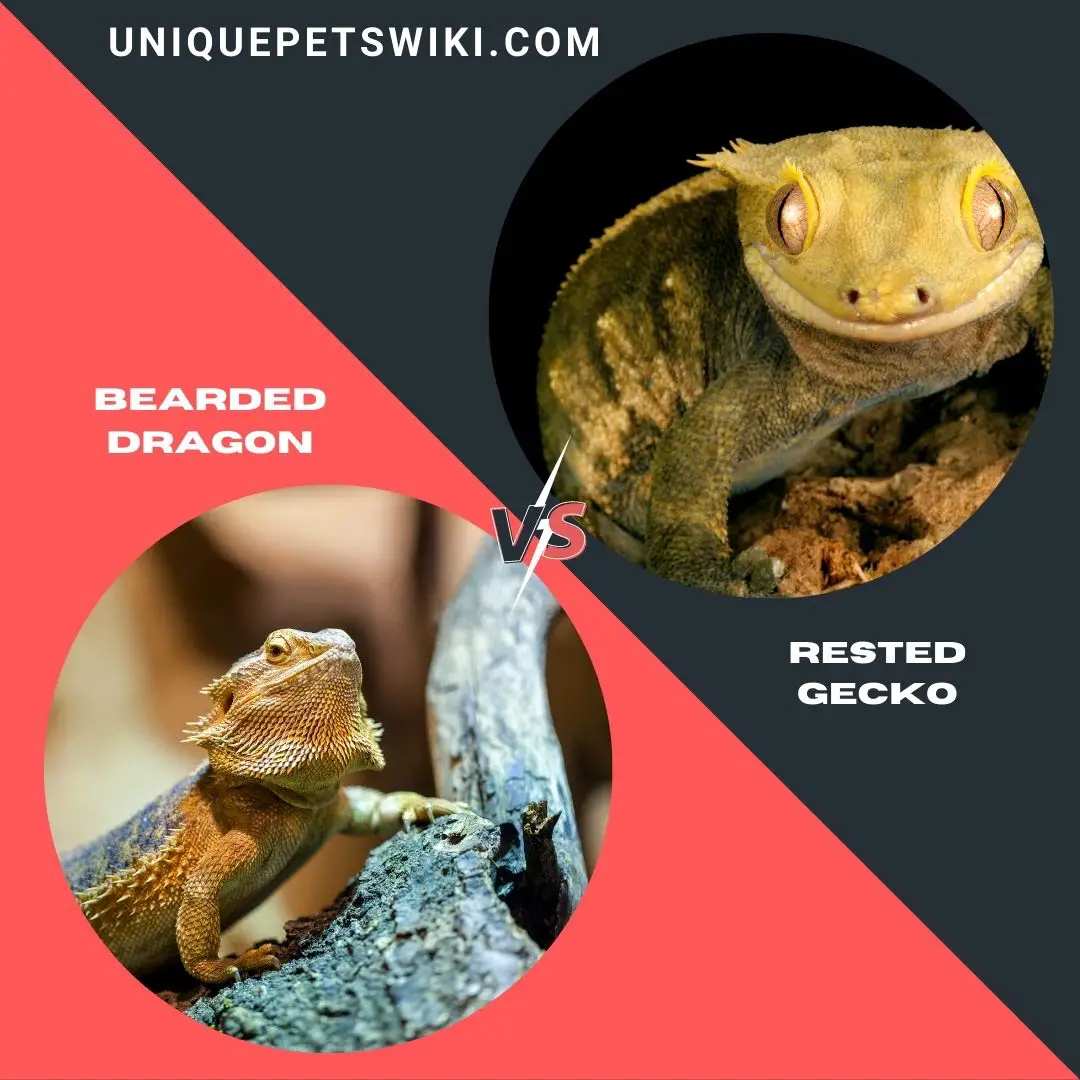The popularity of bearded dragons and crested geckos as pets is increasing tremendously. These lizards possess distinctive attributes that make them outstanding pets, and many reptile keepers admire and treasure them much.
Many reptile enthusiasts find themselves in a dilemma when choosing between a bearded dragon and a crested gecko. Sometimes the resources are limited and won’t allow you to own two reptile companions concurrently.
Consequently, it requires you to choose a pet that you will raise with ease. How well you know these reptile lizards will help you make a sound conclusion.
This is the place to be if your heart is set on knowing the difference between bearded dragons and crested geckos as pets. Keep on reading for more!
Contents
Bearded Dragon or Crested Gecko: Full comparison
Before owning any animal companion, always make sure that this pet you’re bringing won’t suffer in either way under your care. Every reptile pet needs to live happily and well and in a comfortable environment.
Bearded dragons and crested geckos are indeed wonderful pets, but how well they will live with you depends on your care. These two pets have different requirements as pets for them to thrive well.
We’re going to see how crested geckos and the beardies differ from each other by considering their habitat, diet, required care, lifespan, active level, personality, etc. Don’t get impatient, as there is a lot of good stuff to learn further in the article.
Physical Description About Species
The captive bearded dragon colors are elegant. Brown, tan, and gray are the most common colors of wild bearded dragons.
Thanks to selective breeding, today, bearded dragons display significant colors, including orange, red, white, yellow, and black. These lizards come in different morphs that are incredibly striking and captivating.
Furthermore, the beardies have rubbery spikes on their body’s edge and head, plus small uneven scales that make them appear rough. An abundance of spikes exists on the throat pouch, forming a beard.
Comparably, crested geckos are good-looking with numerous morphs that come with variable colors, including chocolate, near-black, yellow, orange, cream, etc. Crested geckos possess soft skin with crests, and they don’t have eyelids.
Their distinctive eyelashes make them super gorgeous. In conclusion, both crested geckos and bearded dragons are physically beautiful.

Size, Weight, and Lifespan
On average, bearded dragons tend to live approximately 8-12 years, but some will even reach 20 years under extreme care.
How big a beardie can get varies depending on a combination of factors. The adults grow to around 16-24 inches and weigh approximately 250-465 grams. German giants can grow as long as 32 inches and weigh up to 1000 grams.
Captivated crested geckos live for about 15-20 years but survive as little as ten years or below when poorly kept.
Crested geckos are relatively small compared to bearded dragons. Adults grow anywhere from 7-9 inches long and weigh an average of 55-65 grams.
To summarize, bearded dragons are pretty large and heavy compared to crested geckos. But both lizards have a close lifespan.
Habitat
The beardies are native to the deserts of Australia, and as such, they require to live in warm and dry areas. Typically, bearded dragons’ preferred home is in deserts, rocky areas, savannas, subtropical woodlands, and scrublands.
So, the temperature is a primary consideration if you’re looking forward to designing a perfect terrarium for a beardie.
Contrarily, crested geckos thrive well in warm and humid areas. They are native to the tropical rainforests of New Caledonia. Primarily, these lizards live in the lower areas of the forests close to the ground floor.

Active Level
The beardies are diurnal lizards. They are exceptionally active during the day, and you will often see them climbing the branches and objects in the terrarium. Basking is also a primary activity for the beardie in the daytime.
It is uncommon to see a bearded dragon sleeping during the day, but they’re all deep asleep at night. Their sleeping pattern is dependent on heat and light.
On the other hand, crested geckos are nocturnal and crepuscular lizards. They get busy at night climbing from branches to branches.
Being crepuscular tells you that crested geckos are one kind of lizards that are active in the twilight, at dusk, and dawn.
In summary, beardies are active in the daytime, but crested geckos become active at night, particularly in the twilight.
Personality and Defence Mechanisms
Bearded dragons are fascinating pets that exceedingly enjoy the company of their owners. They are pretty social and tolerant of handling.
These lizards get excited being outside the tank and playing with their keepers. It’s a kind of reptile pet that no one gets bored having around.

Crested geckos are docile and also appreciate handling. They have a friendly personality and rarely become aggressive towards their owners.
When it comes to antipredator behaviors, bearded dragons display various, including camouflaging, hissing, gaping and biting, and fluffing.
Fluffing is their most common defense mechanism, where the lizard opens its mouth, puffs up the beard that suddenly becomes jet black, and fortunately scares most predators.
Crested geckos will avoid by all means from becoming prey too. Their most antipredator behavior is tail dropping. They typically drop their tail when a predator grabs them by the time.
Furthermore, these lizards tend to run away or open their mouths to scare predators and perhaps bite.
In conclusion, bearded dragons and crested geckos have warm personalities and are good at defending themselves. However, bearded dragons usually don’t drop their tails. The large size of the beardie also makes them easier to handle.
Diet
Bearded dragons are easy to feed because they eat a diversity of foods; they are omnivores. The food formulation for these lizards varies greatly depending on their age.
The babies and juveniles will need to eat 60-80% feeder bugs and 20-40% plant matter. Contrastingly, adult bearded dragons require a diet consisting of 80% plant matter and 20% insect protein.
The best foods for bearded dragons include phoenix worms, crickets, super worms, earthworms, collard greens, turnip greens, green beans, peaches, plums, carrots, sweet potato, bell pepper, dandelion greens, etc.
Moreover, bearded dragons have a high demand for calcium which comes from foods or through supplements.
Crested geckos are omnivores too. Their diet primarily contains insects, fruits, and flowers, with a small portion of vegetables and leafy greens
Crested geckos’ favorite foods are waxworms, watermelon, dandelions, silkworms, crickets, butternut squash, apricot, blueberries, etc.
Visit the article on the crested gecko diet list to know the complete diet of these reptiles. While baby geckos need to eat every day, the adults should eat every other day.
Likewise, baby beardies have to eat a couple of times per day and adults at least three days per week.

Breeding
The breeding season in bearded dragons lasts through September to March. These lizards are sexually mature at 18 months old. Males can successfully mate at this age, but females should begin breeding at a minimum of 24 months old.
The recommended minimum weight for a breeding female bearded dragon is 350 grams. Bearded dragons are oviparous, indicating that they lay eggs that hatch into newborns.
They can lay eggs with or without mating. A female beardie lays approximately 2-5 clutches per year, with each clutch carrying 20-40 eggs.
On the other hand, crested geckos typically breeds through March to October. They are sexually mature at 6-10 months old, but their minimum mating age should be 18-24 months.
Generally, crested geckos lay anywhere from 6-7 clutches throughout the breeding season, and each clutch may contain 1-2 eggs. Similar to the beardies, a crested gecko can become gravid without mating.
In summary, the mating age for bearded dragons and crested geckos is significantly indifferent, and it’s easy to breed all of them. The beardies lay more eggs than crested geckos.
Brumation
Bearded dragons are known to brumate in colder months. They stay dormant and often sleep to escape the extreme cold during these moments.
However, brumation is not a thing for all bearded dragons. Those beardies that brumate can remain sleeping for several weeks or months, approximately 2-3 months.
It is quite the opposite with crested geckos. The natural home to these geckos has temperatures that are somehow constant throughout the year. Hence, no need for them to brumate.
However, when crested geckos experience low temperatures and less light, it’s common for them to become inactive and eat slightly less.
Remember that crested geckos naturally do not brumate while bearded dragons spend most of their colder months in a deep sleep.
Required Take Care
You now know that crested geckos are smaller than bearded dragons. Due to their small size, these lizards will take less space.
The idea of the two lizards having significantly different habitats makes them have different requirements in the terrarium.
Enclosure Size
Bearded dragons are pretty large and therefore take more space. Suitable tank size for adult beardies is anywhere from 55-75-gallon, depending on their size.
Such space will be convenient to include the accessories and leave ample space for the lizard. The beardies aren’t fond of climbing high up on plants; hence they will perfectly fit in a wide horizontal tank.
Crested geckos will thrive well in a tank of 20-30-gallon, and the babies a 10-gallon tank. They are avid climbers and look for high spots and therefore require a vertical terrarium.
The two species require different tanks’ sizes and conformation, in that bearded dragons need a wide horizontal terrarium, and crested geckos a vertical one.
Lighting, Heating, and Humidity Requirements
Bearded dragons are desert dwellers, so they need high basking temperatures of 90-100 or 110℉ and an additional cool temp of 75-85℉. The night temperatures should range between 70-75℉.
Additionally, the beardies need a 35-50% low humidity and a UVB light fixture covering most of the tank’s length.
Crested geckos are inhabitants of tropical areas, and hence they need high humidity of 65-80%. The optimal temp in the warm spot for these geckos ranges from 74-79℉ and the cool spot at 68-70℉.
A 5% UVB may do well for crested geckos, but it’s not compulsory that you provide it. Crested geckos are mostly hiding and sleeping during the day, so they don’t need UVB lighting.
Suitability: Best for Whom?
Bearded dragons are calm and affectionate lizards, plus their social temperament makes them suitable for beginners and children (with supervision).
The overall budget of owning a bearded dragon is slightly high since they require more space, although it’s, fortunately, a one-time cost.
Crested geckos also have cool temperaments. They are calm and tolerant of handling, and this makes them good pets for beginners.
Unfortunately, some unusual behaviors like dropping tails in crested geckos can scare children. These lizards also enjoy jumping, and therefore, only the older children can handle them.
Bearded dragons and crested geckos are good for beginners, but beardies are more favorable because they are easy to handle.
Costs
A bearded dragon costs anywhere from $60-$100 or even less depending on the morphs and where you are buying.
If you decide to own a beardie, you will spend several dollars on electricity every month and replace their UVB lighting every six months.
The weekly budget for the food of baby bearded dragons is around $20, but for adults is $20-$30 per month.
On the other hand, crested geckos require less food and are easy to maintain; thus, their budget is low. Approximately $30 is enough to feed these lizards in a month.
In summary, crested geckos are relatively cheaper to keep and maintain than bearded dragons. The baby dragons are pretty expensive to feed since they mainly eat insects.
Ability to Keep in Groups
Bearded dragons become territorial and are pretty aggressive when another beardie invades their habitat. They are not the lizards to keep in one cage since they can easily injure each other.
Several female crested geckos can share a habitat without fighting. Likewise, you can house one male and a few females in the same tank.
However, never attempt to keep two male crested geckos under the same terrarium, as they will fight and hurt each other.
Always consider the size and age of female crested geckos when you want to house them together. Their sizes should be uniform to prevent bullying.
Also, having a male living with females may encourage early breeding, which is not healthy for the females. So, it is best to house them separately.
Can You Keep Bearded Dragon and Crested Gecko Together?
No, bearded dragons and crested geckos cannot live together. They are different species and have exceedingly different needs.
It is not possible to satisfy the needs of one reptile lizard without compromising the needs of the other.
For instance, bearded dragons need a dry, warm, and wide horizontal tank, while crested geckos need a humid and vertical terrarium.
Moreover, bearded dragons will mistreat and hurt crested geckos since they are territorial. Another discouraging for keeping the beardies and crested geckos together is their size.
Bearded dragons are larger and have sharp teeth with more biting power; you can see that the poor and small crested geckos are not safe in the presence of the beardies.
Conclusion
That is all you needed, to familiarize yourself with bearded dragons and crested geckos, and see which makes a perfect pet. Fortunately, crested geckos and beardies are all good pets and suitable for beginners.
If you are looking for a lizard pet that you will be playing and hanging around with during the day, you will need to choose a bearded dragon.
If you want a cheap lizard to maintain, a crested gecko will be a good choice. They eat less and have few requirements with their lighting.
Both the crested geckos and bearded dragons are fascinating lizards. They all possess special and unique attributes and also have different requirements.
Hopefully, the pros and cons of bearded dragons and crested geckos provided in this article will give you an easy time choosing the pet you want.
